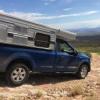Edited by Stokeme, 02 August 2020 - 10:20 PM.

LiFePO4Blue Brand Battery & DC-DC Chargers
#11

Posted 02 August 2020 - 04:30 PM
#12

Posted 03 August 2020 - 12:22 PM
I'm in the process of building my battery pack. Waiting for the cells to come. BMS is here today. All ordered from either Alibaba or Aliexpress. I think It got 120ah batteries (Lifepro4) for about $158. Half of that is shipping. Pretty easy to do, smalller and lighter than my AGM.
Boise, ID
2022 Chevy 3500 HD
2023 FWC Flatbed Hawk
#13

Posted 03 August 2020 - 04:21 PM
Bluetooth is nice but I've found once I got my system properly configured I don't have much need to keep an eye on it.
Craig K6JGV_________________________ 2004 2500 CTD 4X4 FWC HAWK 1960 CJ5
#14

Posted 03 August 2020 - 08:15 PM
Thanks to everyone for the very helpful info.
I've decided to go the DIY route and have ordered the Li cells and BMS.
The prismatic cells make for a smaller battery than cylindrical cells, with a downside of somewhat higher cost and somewhat poorer heat dissipation. For my setup, I don't expect to operate at high current or in extreme heat and I really like the smaller size - I'll move the inverter from under the dinette seat to the battery compartment on our front dinette Fleet. The inverter is really only for emergencies, like when I forgot to bring the 12 V charger for my laptop.
LiFePO4 batteries are less tolerant of temperature extremes than AGMs but the BMS provides protection, and I can check with Bluetooth. I can always disable the battery via Bluetooth and get a few minutes of power from running the truck, if needed.
I came across the following quote from BattleBorn's CEO in 2018: "In any case we decided early on to not put Bluetooth internally because 1) you can monitor cycles SOC, V, current, etc. externally using Victron equipment among others, 2) we were concerned that the battery would last longer than the Bluetooth version since that changes rapidly, and 3) we did not want to include something internally that could break over time when we find it not completely necessary."
I think he missed the boat. Bluetooth is backward compatible and almost assuredly will be. Bluetooth eliminates the need for a lot of external expensive displays and controls. V & A give me a rough idea of battery SoC and the BMS SoC gives me an accurate reading - which alone saves me about $200 for a battery monitor.
Edited by Jack, 03 August 2020 - 08:17 PM.
2015 Fleet on 2019 Ranger
#15

Posted 04 August 2020 - 01:16 PM
Thanks to everyone for the very helpful info.
I've decided to go the DIY route and have ordered the Li cells and BMS.
The prismatic cells make for a smaller battery than cylindrical cells, with a downside of somewhat higher cost and somewhat poorer heat dissipation. For my setup, I don't expect to operate at high current or in extreme heat and I really like the smaller size - I'll move the inverter from under the dinette seat to the battery compartment on our front dinette Fleet. The inverter is really only for emergencies, like when I forgot to bring the 12 V charger for my laptop.
LiFePO4 batteries are less tolerant of temperature extremes than AGMs but the BMS provides protection, and I can check with Bluetooth. I can always disable the battery via Bluetooth and get a few minutes of power from running the truck, if needed.
I came across the following quote from BattleBorn's CEO in 2018: "In any case we decided early on to not put Bluetooth internally because 1) you can monitor cycles SOC, V, current, etc. externally using Victron equipment among others, 2) we were concerned that the battery would last longer than the Bluetooth version since that changes rapidly, and 3) we did not want to include something internally that could break over time when we find it not completely necessary."
I think he missed the boat. Bluetooth is backward compatible and almost assuredly will be. Bluetooth eliminates the need for a lot of external expensive displays and controls. V & A give me a rough idea of battery SoC and the BMS SoC gives me an accurate reading - which alone saves me about $200 for a battery monitor.
I too ordered my batteries, etc. for a DIY. The BMS showed up yesterday. Batteries are somewhere on the ocean (from China). There are only a few manufacturers of cells and they mainly seem to be in China. A lot of the DIY parts in the US are sourced from China so if you want to take the risk and order yourself (I did), you can save $'s. If you want to deal with a US distributor it's a bit more expensive but safer. I can't wait to get the cells in. I've got just about everything else to finish the project.
Good luck! If you have everything already, please post an update when you are done.
My BMS bluetooth was only about $7 so even if I don't use it after I get the profiles set up, it really doesn't matter.
Boise, ID
2022 Chevy 3500 HD
2023 FWC Flatbed Hawk
#16

Posted 13 August 2020 - 12:41 AM
It was fairly easy to install my new 200 AH LifeBlue battery in the battery box. I have a 2016 Grandby with front dinette. The battery box is near the door in the back. I just removed the wood bars that held in the old batteries, removed the two velcro tie downs, and slid in the new battery. Here is how it looked after hooking it up to test it out.
 35 - 1 (1).jpeg 42.19K
57 downloads
35 - 1 (1).jpeg 42.19K
57 downloads
Here is a shot of the top of the battery showing the new data port (the black thing), and a reset button.
 35 - 1 (4).jpeg 56.41K
54 downloads
35 - 1 (4).jpeg 56.41K
54 downloads
Here are two shots of the bluetooth monitor on my i-pad. It also works on my i-phone.
 35 - 1 (2).jpeg 17.58K
52 downloads
35 - 1 (2).jpeg 17.58K
52 downloads
 35 - 1 (3).jpeg 18.78K
39 downloads
35 - 1 (3).jpeg 18.78K
39 downloads
I then tested the my three charging sources. The alternator with my BlueSea ACR does not work well with this lithium battery. I disabled solar and no shore power, and the BlueSea triggered on, showing amp reading of -1.2 amp to -.6 amp. In other words, the BlueSea turned on and joined the new lithium and the engine starting battery, I assume because the Lithium battery was at a higher voltage than the engine start battery, so it began to charge the engine start battery from my new lithium battery. I then turned on the engine and let it idle. At first I got about +7.4 amps, but within minutes it read -4.1 amp. After 3 min it read -3.6 amp. If I raced the engine a bit it got to about 0 amps. I have a 2016 Ford F150 with what I assume is one of the new smart alternator systems. I think that that the system sees the BlueLife Lithium battery as a source of power, and so shuts off the alternator to save gas. Not really what I want. With mysmart alternator and the BlueSea ACR, I don't get much any charging at all from the engine, and in fact it is really a drain on the LifeBlue. I don't see that increasing the wire size would solve this problem, so I am going to buy a Victron 12/12 30 amp DC-DC charger and see how that works.
I then tested how my IOTA DLS30/IQ4 charger that came with the camper worked. With solar disabled I plugged it in to 110 AC shore power. Engine off and the BlueSea ACR disabled. According to my LifeBlue bluetooth monitor, I got from about 5 to 7 amps charging. Not sure why it is so low, but I did use it (with my solar) to eventually charge up LifeBlue to 99% State of Charge. So the IOTA works, sort of, and very slowly. To solve this problem I am in the process of installing a Progressive Dynamics PD9145AL, which is a 45 amp charger strictly for lithium batteries. In another post I will detail my installation of the Progressive Dynamics.
I then tested the solar only charging. BlueSea disabled, no shore power, no engine, in full sun at about 1:30 pm on a very hot day. My BlueLife bluetooth monitor read about 19 to 20 amps, which is about what I expect. No changes anticipated to this aspect of my system.
Since I mostly boondock, and almost never use hook up at a campground, I could just rely solely on solar and be done with it. But I need a project since it is too hot to camp around here right now, so I am going to change the IOTA for the Progressive Dynamics, add the Victron 12/12 30 DC-DC charger, and eliminate the BlueSea ACR completely.
#17

Posted 13 August 2020 - 01:25 AM
My new Progressive Dynamics arrived and I have been busy tearing the camper apart to remove the IOTA. It was not that easy. I removed the lower panel, basically. It was made harder by the fact that FourWheel Camper totally sealed the battery box by running beads of some kind of clear caulk at all joints, including the joints where the lower panel was attached. I had to cut this all away with a knife. I don't know exactly why they do this. Maybe some kind of California safety law requires a sealed battery box. There are two 2 inch vents to the outside, but other than that the battery box is totally sealed. I could understand this if you were running old flooded lead acid batteries which can possibly vent dangerous gas. But especially with a lithium battery I don't see that this total sealing of the battery box is necessary. I don't intend to re-seal the battery box when I am done.
In fact I added a small "muffin" fan in the space where the CO detector was located. My CO detector was constantly going off, sometimes in the middle of the night, for no good reason, so I disabled it some time ago. I finally replaced it with combination CO and smoke detector in place of the factory smoke detector. I got one with a 10 year lithium battery, and so far no false alarms. At any rate I removed the old CO detector and used the wires to hook up my little fan, and wired it to a switch. I had two spare switch spots and bought a switch to match. Lithium batteries don't like heat, and I do have my Solar controller in the same box as my battery, which can produce some heat. So I thought a little ventilation might occasionally be useful.
The old IOTA 30 amp charger was not that easy to remove, as it is all very tight there, but I finally got it out. They wired it in to 110 AC via a hard wire, not a plug. So I will have to wire up my new Progressive Dynamics the same way. Not a problem, but Progressive Dynamics says that cutting the power cord voids the warranty. Oh well, I will take the chance. The Progressive Dynamics is a bit deeper than the IOTA, but it still fits fine.
Progressive Dyamics emphasizes that you should only replace your old charge with one of the same amp rating, and not increase it. I am ignoring this advise and going from 30 amp to 45 amp. To do this I am wiring up dedicated 6 AWG cables from the battery to the new charger. Since the charger is right next to the battery, the cable length is less than 3 feet, so I don't think I will have an issue with increasing my amperage. At the same time I am wiring up 6 AWG cables from the battery to the place for the new Victron 12/12 DC-C charger. It is located about 6 feet from the battery, which is not ideal but I think it will all work.
The 200 AH LifeBlue battery can accept a charge of up to 120 amps! So I didn't want to use a wimpy 30 amp charger. I could have gone even higher, but the higher amp Progressive Dynamics units are bigger and might not fit. So, if I was plugged in at a campground, and generating 30 amps solar and 45 amps from the PD unit, I would be charging at 65 amps, well within the limit of the battery.
The main use of shore power for me is to charge up the battery just prior to a trip. With the camper in the garage, and the refrigerator on cooling all my food, I need to charge up the battery to near full for a typical boondocking trip. So I just plug it in and I am good to go in the morning.
Here is a picture of work in progress with the bottom panel removed and the old IOTA removed.
 35 - 1.jpeg 80.86K
37 downloads
35 - 1.jpeg 80.86K
37 downloads
#18

Posted 13 August 2020 - 05:03 PM
Thanks Zirdu. This is a very helpful post. Does your Iota not have the IQ4 port to put in the IQ4-Li? Mine is older, circa 2008, but haven't actually monitored the charging profile from shore power yet.
I'm curious to see what you get with the Victron Orion with 6awg, I did the same thing.
2021 Ford XL SuperCrew HD Payload Pkg
2008 FWC Hawk
Western Colorado, USA
Instagram: @lukeyfiasco
#19

Posted 13 August 2020 - 08:30 PM
My IOTA has the IQ4 (for Lead Acid or AGM battery) built in, and cannot accept a plug in for a IQ4 lithium module. So I had to change the entire charger. I used this as an excuse to increase the amp capacity of the charger. Will see how it works.
The Victron Orion DC-DC 30 amp charger must be popular, since it is on back order everywhere. What kind of charging do you get from your alternator with your system?
#20

Posted 14 August 2020 - 01:27 AM
First time I set it up I was getting ~22-23 of amps in.
Honestly, haven't really messed around with it yet or used it to recharge a depleted battery. Was planning on doing some more testing.
Saw about ~260 watts when I fired up the truck this afternoon with the truck in park.
2021 Ford XL SuperCrew HD Payload Pkg
2008 FWC Hawk
Western Colorado, USA
Instagram: @lukeyfiasco
0 user(s) are reading this topic
0 members, 0 guests, 0 anonymous users














